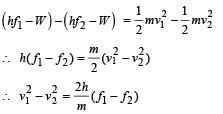Test: JEE Main 35 Year PYQs- Modern Physics - JEE MCQ
30 Questions MCQ Test - Test: JEE Main 35 Year PYQs- Modern Physics
If 13.6 eV energy is required to ionize the hydrogen atom, then the energy required to remove an electron from n = 2 is
At a specific instant emission of radioactive compound is deflected in a magnetic field. The compound can emit
(i) electrons
(ii) protons
(iii) He2+
(iv) neutrons
The emission at instant can be
(ii) protons
(iii) He2+
(iv) neutrons
Sodium and copper have work functions 2.3 eV and 4.5 eV respectively. Then the ratio of the wavelengths is nearest to
Formation of covalent bonds in compounds exhibits
If N0 is the original mass of the substance of half-life period t1/2 = 5 years, then the amount of substance left after 15 years is
By increasing the temperature, the specific resistance of a conductor and a semiconductor
The part of a transistor which is most heavily doped to produce large number of majority carriers is
Which of the following are not electromagnetic waves?
A strip of copper and another of germanium are cooled from room temperature to 80K. The resistance of
Which of the following radiations has the least wavelength ?
When a U238 nucleus originally at rest, decays by emitting an alpha particle having a speed ‘u’, the recoil speed of the residual nucleus is
The difference in the variation of resistance with temeperature in a metal and a semiconductor arises essentially due to the difference in the
A radioactive sample at any instant has its disintegration rate 5000 disintegrations per minute. After 5 minutes, the rate is 1250 disintegrations per minute. Then, the decay constant (per minute) is
A nucleus with Z = 92 emits the following in a sequence:

Then Z of the resulting nucleus is
Two identical photocathodes receive light of frequencies f1 and f2. If the velocites of the photo electrons (of mass m) coming out are respectively v1 and v2, then
Which of the following cannot be emitted by radioactive substances during their decay ?
In the nuclear fusion reaction

given that the repulsive potential energy between the two nuclei is ~ 7.7 × 10 -14 J , the temperature at which the gases must be heated to initiate the reaction is nearly [Boltzmann’s Constant k = 1.38 × 10 -23 J/K]
Which of the following atoms has the lowest ionization potential ?
The wavelengths involved in the spectrum of deuterium  are slightly different from that of hydrogen spectrum, because
are slightly different from that of hydrogen spectrum, because
In the middle of the depletion layer of a reverse- biased p-n junction, the
If the binding energy of the electron in a hydrogen atom is 13.6eV, the energy required to remove the electron from the first excited state of Li ++ is
A radiation of energy E falls normally on a perfectly reflecting surface. The momentum transferred to the surface is
According to Einstein’s photoelectric equation, the plot of the kinetic energy of the emitted photo electrons from a metal Vs the frequency, of the incident radiation gives as straight the whose slope
The work function of a substance is 4.0 eV. The longest wavelength of light that can cause photoelectron emission from this substance is approximately.
A nucleus disintegrated into two nuclear parts which have their velocities in the ratio of 2 : 1. The ratio of their nuclear sizes will be
The binding energy per nucleon of deuteron  and helium nucleus
and helium nucleus  is 1.1 MeV and 7 MeV respectively.. If two deuteron nuclei react to form a single helium nucleus, then the energy released is
is 1.1 MeV and 7 MeV respectively.. If two deuteron nuclei react to form a single helium nucleus, then the energy released is
An α-particle of energy 5 MeV is scattered through 180º by a fixed uranium nucleus. The distance of closest approach is of the order of
When npn transistor is used as an amplifier























 He Energy released = 4 × (7) – 4(1.1) = 23.6 MeV
He Energy released = 4 × (7) – 4(1.1) = 23.6 MeV












